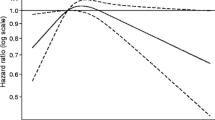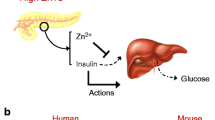Abstract
Aims/hypothesis
SLC30A8 encodes a zinc transporter in the beta cell; individuals with a common missense variant (rs13266634; R325W) in SLC30A8 demonstrate a lower early insulin response to glucose and an increased risk of type 2 diabetes. We hypothesised that zinc supplementation may improve insulin secretion in a genotype-dependent manner.
Methods
We evaluated the early insulin response to glucose (using frequently sampled intravenous glucose tolerance testing) by R325W genotype before and after 14 days of supplementation with oral zinc acetate (50 mg elemental zinc) twice daily in healthy non-diabetic Amish individuals (N = 55).
Results
Individuals with RW/WW genotypes (n = 32) had the lowest insulin response to glucose at 5 and 10 min at baseline (vs RR homozygotes [n = 23]). After zinc supplementation, the RW/WW group experienced 15% and 14% increases in the insulin response to glucose at 5 and 10 min, respectively (p ≤ 0.04), and, compared with RR homozygotes, experienced a 26% (p = 0.04) increase in insulin at 5 min. We observed reciprocal decreases in proinsulin:insulin in the RW/WW (p = 0.002) vs RR group (p = 0.048), suggesting a genotype-specific improvement in insulin processing.
Conclusions/interpretation
Zinc supplementation appears to affect the early insulin response to glucose differentially by rs13266634 genotype and could be beneficial for diabetes prevention and/or treatment for some individuals based on SLC30A8 variation.
Trial registration: ClinicalTrials.gov NCT00981448


Similar content being viewed by others
Abbreviations
- FS-IVGTT:
-
Frequently sampled IVGTT
- HOMA-IR:
-
HOMA of insulin resistance
- SNP:
-
Single nucleotide polymorphism
- ZnT8:
-
Zinc transporter protein member 8
References
Diabetes Prevention Program Research Group (2002) Reduction in the incidence of type 2 diabetes with lifestyle intervention or metformin. N Engl J Med 346:393–403
Jablonski KA, McAteer JB, de Bakker PIW et al (2010) Common variants in 40 genes assessed for diabetes incidence and response to metformin and lifestyle intervention in the diabetes prevention program. Diabetes 59:2672–2681
Andrulionyte L, Zacharova J, Chiasson JL, Laakso M (2004) Common polymorphisms of the PPAR-gamma2 (Pro12Ala) and PGC-1alpha (Gly482Ser) genes are associated with the conversion from impaired glucose tolerance to type 2 diabetes in the STOP-NIDDM trial. Diabetologia 47:2176–2184
Zacharova J, Todorova BR, Chiasson JL, Laakso M (2005) The G-250A substitution in the promoter region of the hepatic lipase gene is associated with the conversion from impaired glucose tolerance to type 2 diabetes: the STOP-NIDDM trial. J Intern Med 257:185–193
Pearson ER, Donnelly LA, Kimber C et al (2007) Variation in TCF7L2 influences therapeutic response to sulfonylureas: a GoDARTS study. Diabetes 56:2178–2182
Zhou K, Bellenguez C, Spencer CC et al (2011) Common variants near ATM are associated with glycemic response to metformin in type 2 diabetes. Nat Genet 43:117–120
Zhou K, Donnelly LA, Kimber CH et al (2009) Reduced-function SLC22A1 polymorphisms encoding organic cation transporter 1 and glycemic response to metformin: a GoDARTS study. Diabetes 58:1434–1439
Meigs JB, Shrader P, Sullivan LM et al (2008) Genotype score in addition to common risk factors for prediction of type 2 diabetes. N Engl J Med 359:2208–2219
Lyssenko V, Jonsson A, Almgren P et al (2008) Clinical risk factors, DNA variants, and the development of type 2 diabetes. N Engl J Med 359:2220–2232
Schmid R, Vollenweider P, Bastardot F, Vaucher J, Waeber G, Marques-Vidal P (2012) Current genetic data do not improve the prediction of type 2 diabetes mellitus: the Colaus Study. J Clin Endocrinol Metab 97:E1338–E1341
Jing YL, Sun QM, Bi Y, Shen SM, Zhu DL (2011) SLC30A8 polymorphism and type 2 diabetes risk: evidence from 27 study groups. Nutr Metab Cardiovasc Dis 21:398–405
Cauchi S, del Guerra S, Choquet H et al (2010) Meta-analysis and functional effects of the SlC30A8 rs13266634 polymorphism on isolated human pancreatic islets. Mol Genet Metab 100:77–82
Sladek R, Rocheleau G, Rung J et al (2007) A genome-wide association study identifies novel risk loci for type 2 diabetes. Nature 445:881–885
Scott LJ, Mohlke KL, Bonnycastle LL et al (2007) A genome-wide association study of type 2 diabetes in Finns detects multiple susceptibility variants. Science (New York, NY) 316:1341–1345
Saxena R, Voight BF, Lyssenko V et al (2007) Genome-wide association analysis identifies loci for type 2 diabetes and triglyceride levels. Science 316:1331–1336
Takeuchi F, Serizawa M, Yamamoto K et al (2009) Confirmation of multiple risk loci and genetic impacts by a genome-wide association study of type 2 diabetes in the Japanese population. Diabetes 58:1690–1699
Chimienti F, Devergnas S, Favier A, Seve M (2004) Identification and cloning of a beta-cell-specific zinc transporter, ZnT-8, localized into insulin secretory granules. Diabetes 53:2330–2337
Dunn MF (2005) Zinc-ligand interactions modulate assembly and stability of the insulin hexamer—a review. Biometals 18:295–303
Hou JC, Min L, Pessin JE (2009) Insulin granule biogenesis, trafficking and exocytosis. Vitam Horm 80:473–506
Boesgaard TW, Zilinskaite J, Vanttinen M et al (2008) The common SLC30A8 Arg325Trp variant is associated with reduced first-phase insulin release in 846 non-diabetic offspring of type 2 diabetes patients—the EUGENE2 study. Diabetologia 51:816–820
Majithia A, Jablonski K, McAteer J et al (2011) Association of the SLC30A8 missense polymorphism R325W with proinsulin levels at baseline and after lifestyle, metformin or troglitazone intervention in the Diabetes Prevention Program. Diabetologia 54:2570–2574
Stancakova A, Kuulasmaa T, Paananen J et al (2009) Association of 18 confirmed susceptibility loci for type 2 diabetes with indices of insulin release, proinsulin conversion, and insulin sensitivity in 5,327 nondiabetic Finnish men. Diabetes 58:2129–2136
Kirchhoff K, Machicao F, Haupt A et al (2008) Polymorphisms in the TCF7L2, CDKAL1 and SLC30A8 genes are associated with impaired proinsulin conversion. Diabetologia 51:597–601
Steinthorsdottir V, Thorleifsson G, Reynisdottir I et al (2007) A variant in CDKAL1 influences insulin response and risk of type 2 diabetes. Nat Genet 39:770–775
Tamaki M, Fujitani Y, Hara A et al (2013) The diabetes-susceptible gene SLC30A8/ZnT8 regulates hepatic insulin clearance. J Clin Invest 123:4513–4524
Levey AS, Bosch JP, Lewis JB, Greene T, Rogers N, Roth D (1999) A more accurate method to estimate glomerular filtration rate from serum creatinine: a new prediction equation. Modification of Diet in Renal Disease Study Group. Ann Intern Med 130:461–470
Hsueh WC, Mitchell BD, Aburomia R et al (2000) Diabetes in the Old Order Amish: characterization and heritability analysis of the Amish Family Diabetes Study. Diabetes Care 23:595–601
Office of Dietary Supplements of the National Institutes of Health (2013) Dietary supplement fact sheet: zinc. Available from http://ods.od.nih.gov/FactSheets/Zinc_pf.asp, Accessed 7 July 2014
Matthews DR, Hosker JP, Rudenski AS, Naylor BA, Treacher DF, Turner RC (1985) Homeostasis model assessment: insulin resistance and beta-cell function from fasting plasma glucose and insulin concentrations in man. Diabetologia 28:412–419
Kazi TG, Afridi HI, Kazi N et al (2008) Copper, chromium, manganese, iron, nickel, and zinc levels in biological samples of diabetes mellitus patients. Biol Trace Elem Res 122:1–18
Yerlikaya FH, Toker A, Aribas A (2013) Serum trace elements in obese women with or without diabetes. Indian J Med Res 137:339–345
Sun Q, van Dam RM, Willett WC, Hu FB (2009) Prospective study of zinc intake and risk of type 2 diabetes in women. Diabetes Care 32:629–634
Capdor J, Foster M, Petocz P, Samman S (2013) Zinc and glycemic control: a meta-analysis of randomised placebo controlled supplementation trials in humans. J Trace Elem Med Biol: Organ Soc Miner Trace Elem 27:137–142
Jayawardena R, Ranasinghe P, Galappatthy P, Malkanthi R, Constantine G, Katulanda P (2012) Effects of zinc supplementation on diabetes mellitus: a systematic review and meta-analysis. Diabetol Metab Syndr 4:13
Shan Z, Bao W, Zhang Y et al (2014) Interactions between zinc transporter-8 gene (SLC30A8) and plasma zinc concentrations for impaired glucose regulation and type 2 diabetes. Diabetes 63:1796–1803
Porter RS (ed) (2011) The Merck manual of diagnosis and therapy. Merck Sharp & Dohme, Whitehouse Station
Xu J, Zhou Q, Liu G, Tan Y, Cai L (2013) Analysis of serum and urinal copper and zinc in Chinese northeast population with the prediabetes or diabetes with and without complications. Oxidative Med Cell Longev 2013:635214
Hotz C, Peerson JM, Brown KH (2003) Suggested lower cutoffs of serum zinc concentrations for assessing zinc status: reanalysis of the Second National Health and Nutrition Examination Survey data (1976-1980). Am J Clin Nutr 78:756–764
Patel C, Chen R, Kodama K, Ioannidis JA, Butte A (2013) Systematic identification of interaction effects between genome- and environment-wide associations in type 2 diabetes mellitus. Hum Genet 132:495–508
Kanoni S, Nettleton JA, Hivert M-F et al (2011) Total zinc intake may modify the glucose-raising effect of a zinc transporter (SLC30A8) variant. Diabetes 60:2407–2416
Nicolson TJ, Bellomo EA, Wijesekara N et al (2009) Insulin storage and glucose homeostasis in mice null for the granule zinc transporter ZnT8 and studies of the type 2 diabetes-associated variants. Diabetes 58:2070–2083
Lemaire K, Ravier MA, Schraenen A et al (2009) Insulin crystallization depends on zinc transporter ZnT8 expression, but is not required for normal glucose homeostasis in mice. Proc Natl Acad Sci U S A 106:14872–14877
Wijesekara N, Dai FF, Hardy AB et al (2010) Beta cell-specific ZnT8 deletion in mice causes marked defects in insulin processing, crystallisation and secretion. Diabetologia 53:1656–1668
Fu Y, Tian W, Pratt EB et al (2009) Down-regulation of ZnT8 expression in INS-1 rat pancreatic beta cells reduces insulin content and glucose-inducible insulin secretion. PLoS One 4:e5679
Chimienti F, Devergnas S, Pattou F et al (2006) In vivo expression and functional characterization of the zinc transporter ZnT8 in glucose-induced insulin secretion. J Cell Sci 119:4199–4206
Pound LD, Sarkar SA, Benninger RK et al (2009) Deletion of the mouse Slc30a8 gene encoding zinc transporter-8 results in impaired insulin secretion. Biochem J 421:371–376
Pound LD, Sarkar SA, Cauchi S et al (2011) Characterization of the human SLC30A8 promoter and intronic enhancer. J Mol Endocrinol 47:251–259
Flannick J, Thorleifsson G, Beer NL et al (2014) Loss-of-function mutations in SLC30A8 protect against type 2 diabetes. Nat Genet 46:357–363
Kim I, Kang ES, Yim YS et al (2011) A low-risk ZnT-8 allele (W325) for post-transplantation diabetes mellitus is protective against cyclosporin A-induced impairment of insulin secretion. Pharmacogenomics J 11:191–198
Weijers RN (2010) Three-dimensional structure of beta-cell-specific zinc transporter, ZnT-8, predicted from the type 2 diabetes-associated gene variant SLC30A8 R325W. Diabetol Metab Syndr 2:33
Acknowledgements
The authors thank G. Brewer (University of Michigan, Ann Arbor, MI, USA) for his advice on the measurement of zinc in this study. The authors thank B. Mitchell and K. Ryan (University of Maryland School of Medicine, Baltimore, MD, USA) for their assistance with analyses. The authors are grateful to the Zinc Insulin Pharmacogenetics study participants and staff at the Amish Research Clinic in Lancaster, PA, USA (University of Maryland School of Medicine).
Funding
This research was supported in part by the Mid-Atlantic Nutrition Obesity Research Center, P30 DK072488, from the National Institutes of Health, National Institute of Diabetes and Digestive and Kidney Diseases and by The Johns Hopkins Clinical Research Scholars Program (1KL2 RR025006).
Duality of interest
The authors have no conflicts of interest to disclose. Adeona Pharmaceuticals (Ann Arbor, MI, USA) provided measurement of serum zinc free of charge.
Contribution statement
NMM refined the study design, collected and interpreted the data, and drafted and revised the manuscript. MF collected and interpreted the data, contributed to the methods of the manuscript and reviewed/edited the manuscript. JMC refined the study design, interpreted the data and reviewed/edited the manuscript. ARS refined the study design, collected and interpreted the data and reviewed/edited the manuscript. WHLK interpreted the data and reviewed/edited the manuscript. All authors approved the final version of the paper except for WHLK, who died before she was able to do so. NMM takes responsibility for the contents of this article.
Author information
Authors and Affiliations
Corresponding author
Electronic supplementary material
Below is the link to the electronic supplementary material.
ESM Table 1
(PDF 36 kb)
ESM Table 2
(PDF 35 kb)
ESM Table 3
(PDF 26 kb)
ESM Fig. 1
(PDF 57 kb)
Rights and permissions
About this article
Cite this article
Maruthur, N.M., Clark, J.M., Fu, M. et al. Effect of zinc supplementation on insulin secretion: interaction between zinc and SLC30A8 genotype in Old Order Amish. Diabetologia 58, 295–303 (2015). https://doi.org/10.1007/s00125-014-3419-1
Received:
Accepted:
Published:
Issue Date:
DOI: https://doi.org/10.1007/s00125-014-3419-1




